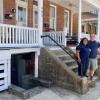Milton council rethinks one-way streets study

Milton Town Council unanimously voted to return a $10,000 state grant intended to fund a feasibility study looking at converting four of the town’s main streets to one-way streets, and plans to reexamine how to improve the town’s traffic system going forward.
At council’s March 6 meeting, Mayor John Collier said even with the grant, he did not think the town could find the rest of the funding needed for the $120,000 study. He said while something has to be done to prepare for an anticipated influx of traffic due to an increase in surrounding development both in and out of town, he did not think the current course was the right one. Collier recommended the town go back to the drawing board and rethink its strategies, giving back the $10,000 grant.
Changing traffic patterns has been met with resistance, ranging from the Milton Fire Department, which argued that such changes would impair emergency response, to residents, who presented a wide spectrum of concerns.
The changes were proposed in a report from the traffic calming ad hoc committee, which recommended a feasibility study of alternate traffic patterns and potential one-way streets on the four major roadways in town – Chestnut, Federal, Union and Mulberry streets – with the possibility of converting one of the lanes into a bike lane. This study was also intended to look into undergrounding utilities and ways to add parking capacity.
Because the project involved bike lanes, the town was given a $10,000 Delaware Cycling Innovation Grant by the Delaware Department of Transportation. However, engineering estimates for the study put the cost at $120,000. That left two alternatives: Either seek additional grant money or amend the town budget to use reserve funds. Council elected to have Town Manager Kristy Rogers explore other grant opportunities.
At council’s Feb. 6 meeting, Rogers said the study could be pared down to $45,000; although, Rogers said, it was unclear if the $10,000 grant would apply. At that time, council elected to table the proposal.
When the measure was brought back March 6, council received a great deal of public comment before even discussing it.
Mulberry Street resident Susan Fewell said she did not know if she was for the one-way street plan or against it, but that she favored the idea of a study to be able to make an informed decision on whether to do it.
Chandler Street resident Amanda Kilby said she was concerned about the cost of the study, especially after the town increased taxes 17%. She said the town could put those funds to better use, such as fixing existing pavement and improving existing sidewalks, and that making the main streets one-way streets would have a negative impact on emergency response time and on commercial businesses.
Those comments were echoed by Brian Reynolds, president of the Milton Fire Department, who said the department’s biggest concern was the effect on emergency response.
All-way stops
Despite voting in October to send a request to DelDOT to turn several intersections into all-way stops, state transportation officials asked council to make the request via resolutions.
The issue received some attention during the public comment portion of the meeting. Fire Chief Johnny Hopkins said the measure on all-way stops was solving a problem while creating another when it comes to firefighters being able to respond to emergencies. He said the town should look at other areas of town, like at the corner of Mulberry Street and Route 16, where there have been accidents, as places to make traffic changes.
The all-way stop intersections in question are Chestnut/Atlantic/Wharton streets, Federal/Wharton/Mulberry streets, Mulberry and Lavinia streets, and Mulberry and Magnolia streets and Lake Avenue. The first resolution, for Chestnut/Atlantic/Wharton streets, passed by a 5-2 vote with council members Harvey and Lee Revis-Plank opposed, and the second resolution, for the remaining streets, passed by a 4-3 vote, with Councilman Larry Savage joining Harvey and Revis-Plank in opposition.



















































